Page 369 of 474
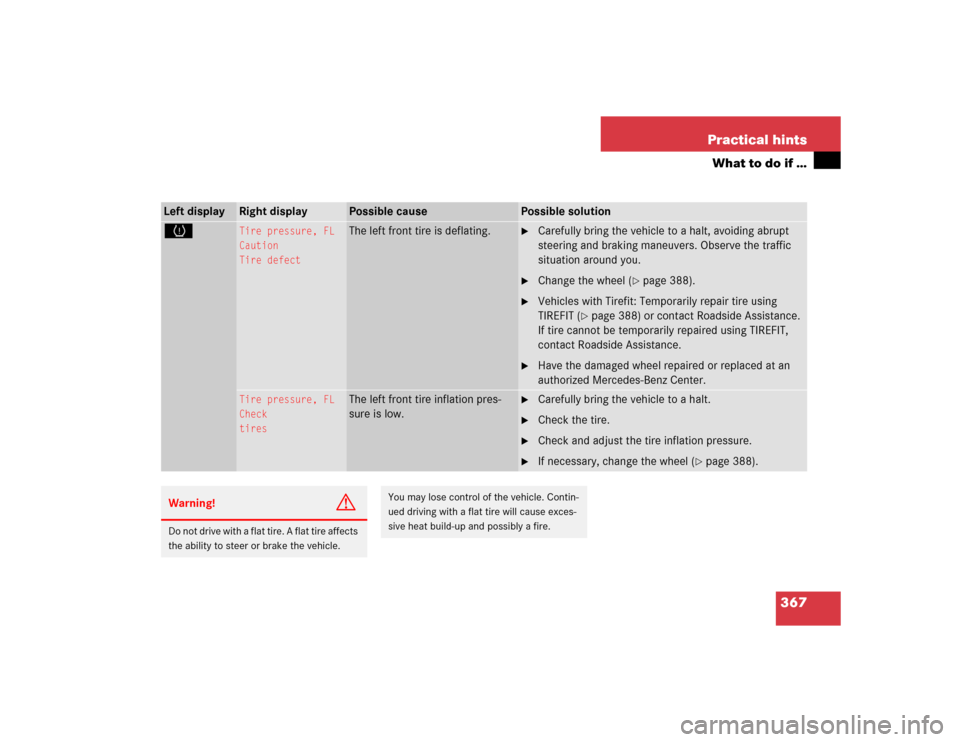
367 Practical hints
What to do if …
Left display
Right display
Possible cause
Possible solution
H
Tire pressure, FL
Caution
Tire defect
The left front tire is deflating.
�
Carefully bring the vehicle to a halt, avoiding abrupt
steering and braking maneuvers. Observe the traffic
situation around you.
�
Change the wheel (
�page 388).
�
Vehicles with Tirefit: Temporarily repair tire using
TIREFIT (
�page 388) or contact Roadside Assistance.
If tire cannot be temporarily repaired using TIREFIT,
contact Roadside Assistance.
�
Have the damaged wheel repaired or replaced at an
authorized Mercedes-Benz Center.
Tire pressure, FL
Check
tires
The left front tire inflation pres-
sure is low.
�
Carefully bring the vehicle to a halt.
�
Check the tire.
�
Check and adjust the tire inflation pressure.
�
If necessary, change the wheel (
�page 388).
Warning!
G
Do not drive with a flat tire. A flat tire affects
the ability to steer or brake the vehicle.
You may lose control of the vehicle. Contin-
ued driving with a flat tire will cause exces-
sive heat build-up and possibly a fire.
Page 370 of 474
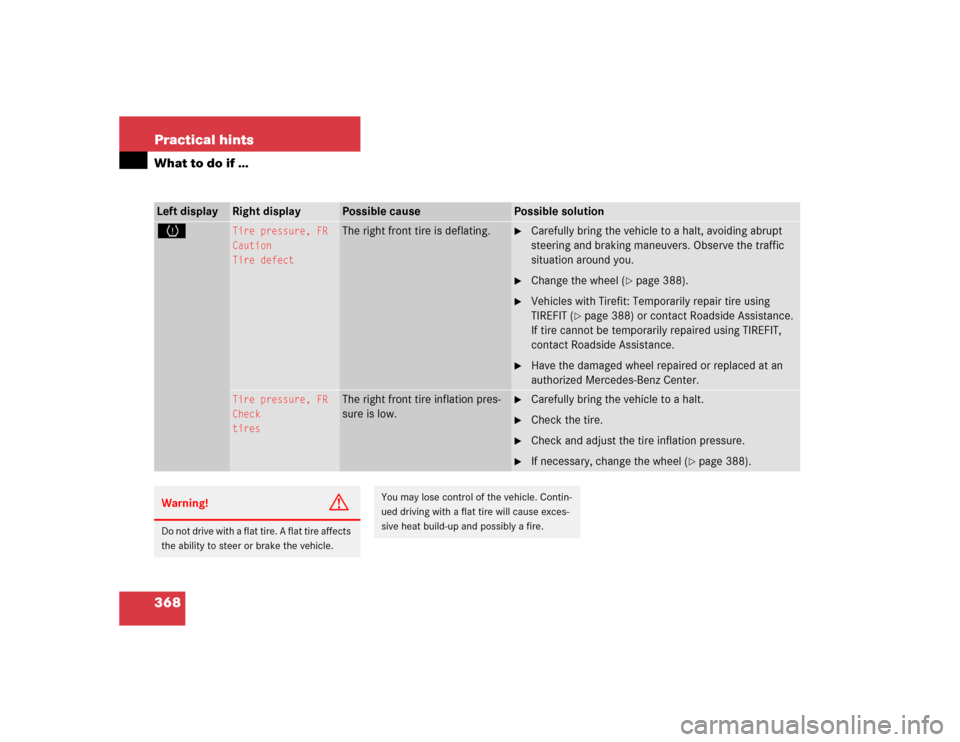
368 Practical hintsWhat to do if …Left display
Right display
Possible cause
Possible solution
H
Tire pressure, FR
Caution
Tire defect
The right front tire is deflating.
�
Carefully bring the vehicle to a halt, avoiding abrupt
steering and braking maneuvers. Observe the traffic
situation around you.
�
Change the wheel (
�page 388).
�
Vehicles with Tirefit: Temporarily repair tire using
TIREFIT (
�page 388) or contact Roadside Assistance.
If tire cannot be temporarily repaired using TIREFIT,
contact Roadside Assistance.
�
Have the damaged wheel repaired or replaced at an
authorized Mercedes-Benz Center.
Tire pressure, FR
Check
tires
The right front tire inflation pres-
sure is low.
�
Carefully bring the vehicle to a halt.
�
Check the tire.
�
Check and adjust the tire inflation pressure.
�
If necessary, change the wheel (
�page 388).
Warning!
G
Do not drive with a flat tire. A flat tire affects
the ability to steer or brake the vehicle.
You may lose control of the vehicle. Contin-
ued driving with a flat tire will cause exces-
sive heat build-up and possibly a fire.
Page 371 of 474
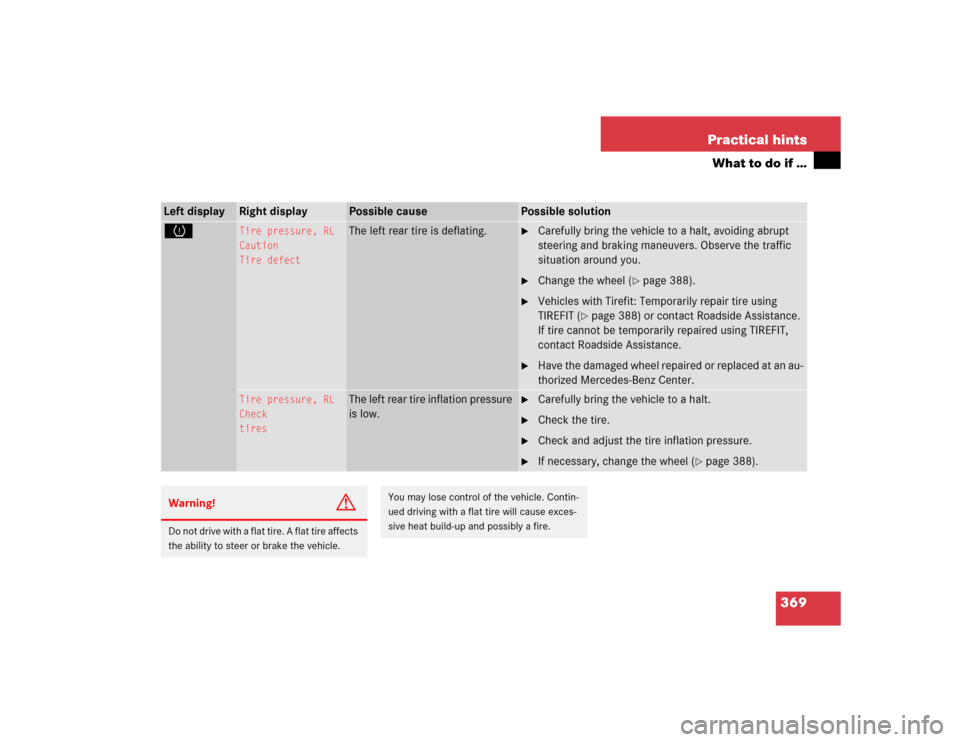
369 Practical hints
What to do if …
Left display
Right display
Possible cause
Possible solution
H
Tire pressure, RL
Caution
Tire defect
The left rear tire is deflating.
�
Carefully bring the vehicle to a halt, avoiding abrupt
steering and braking maneuvers. Observe the traffic
situation around you.
�
Change the wheel (
�page 388).
�
Vehicles with Tirefit: Temporarily repair tire using
TIREFIT (
�page 388) or contact Roadside Assistance.
If tire cannot be temporarily repaired using TIREFIT,
contact Roadside Assistance.
�
Have the damaged wheel repaired or replaced at an au-
thorized Mercedes-Benz Center.
Tire pressure, RL
Check
tires
The left rear tire inflation pressure
is low.
�
Carefully bring the vehicle to a halt.
�
Check the tire.
�
Check and adjust the tire inflation pressure.
�
If necessary, change the wheel (
�page 388).
Warning!
G
Do not drive with a flat tire. A flat tire affects
the ability to steer or brake the vehicle.
You may lose control of the vehicle. Contin-
ued driving with a flat tire will cause exces-
sive heat build-up and possibly a fire.
Page 372 of 474
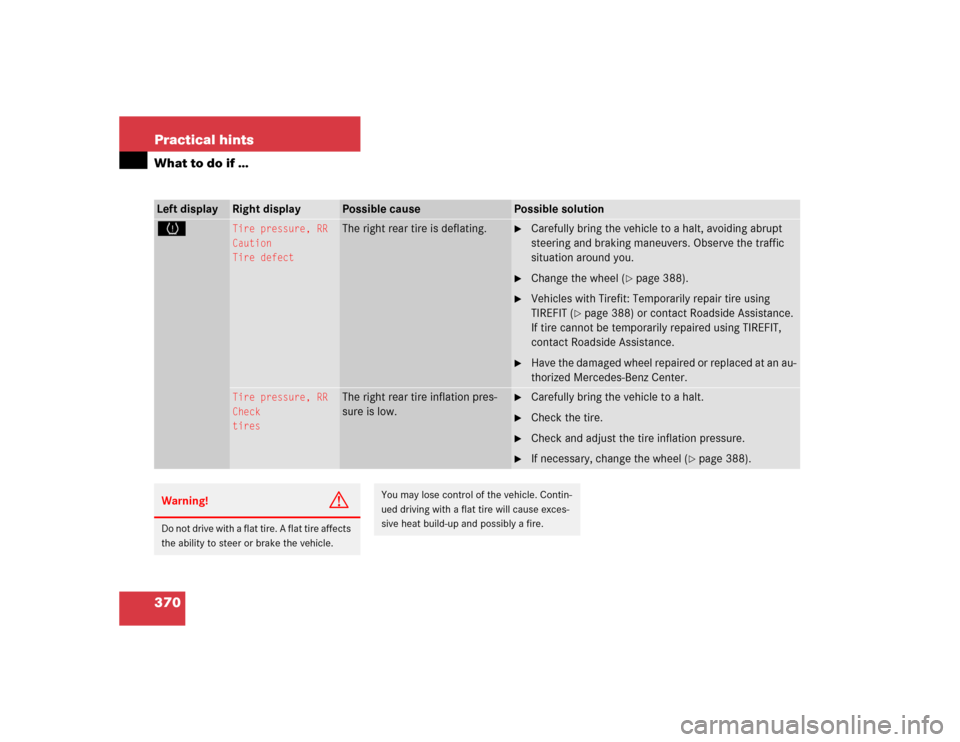
370 Practical hintsWhat to do if …Left display
Right display
Possible cause
Possible solution
H
Tire pressure, RR
Caution
Tire defect
The right rear tire is deflating.
�
Carefully bring the vehicle to a halt, avoiding abrupt
steering and braking maneuvers. Observe the traffic
situation around you.
�
Change the wheel (
�page 388).
�
Vehicles with Tirefit: Temporarily repair tire using
TIREFIT (
�page 388) or contact Roadside Assistance.
If tire cannot be temporarily repaired using TIREFIT,
contact Roadside Assistance.
�
Have the damaged wheel repaired or replaced at an au-
thorized Mercedes-Benz Center.
Tire pressure, RR
Check
tires
The right rear tire inflation pres-
sure is low.
�
Carefully bring the vehicle to a halt.
�
Check the tire.
�
Check and adjust the tire inflation pressure.
�
If necessary, change the wheel (
�page 388).
Warning!
G
Do not drive with a flat tire. A flat tire affects
the ability to steer or brake the vehicle.
You may lose control of the vehicle. Contin-
ued driving with a flat tire will cause exces-
sive heat build-up and possibly a fire.
Page 390 of 474
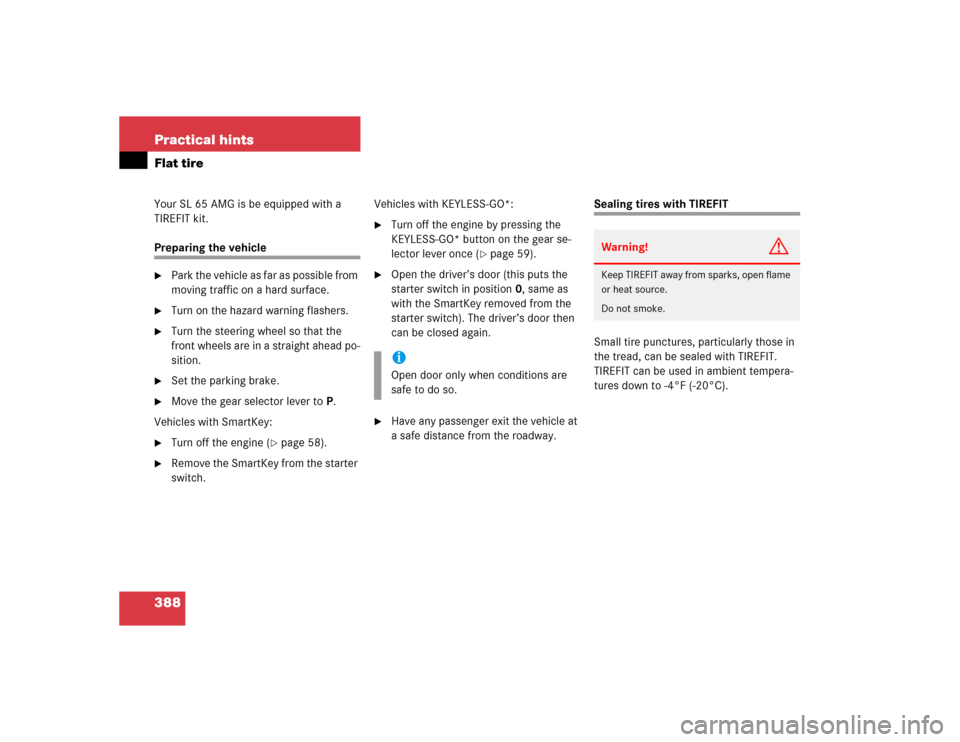
388 Practical hintsFlat tireYour SL 65 AMG is be equipped with a
TIREFIT kit.Preparing the vehicle�
Park the vehicle as far as possible from
moving traffic on a hard surface.
�
Turn on the hazard warning flashers.
�
Turn the steering wheel so that the
front wheels are in a straight ahead po-
sition.
�
Set the parking brake.
�
Move the gear selector lever to P.
Vehicles with SmartKey:
�
Turn off the engine (
�page 58).
�
Remove the SmartKey from the starter
switch.Vehicles with KEYLESS-GO*:
�
Turn off the engine by pressing the
KEYLESS-GO* button on the gear se-
lector lever once (
�page 59).
�
Open the driver’s door (this puts the
starter switch in position 0, same as
with the SmartKey removed from the
starter switch). The driver’s door then
can be closed again.
�
Have any passenger exit the vehicle at
a safe distance from the roadway.
Sealing tires with TIREFIT
Small tire punctures, particularly those in
the tread, can be sealed with TIREFIT.
TIREFIT can be used in ambient tempera-
tures down to -4°F (-20°C).
iOpen door only when conditions are
safe to do so.
Warning!
G
Keep TIREFIT away from sparks, open flame
or heat source.
Do not smoke.
Page 394 of 474
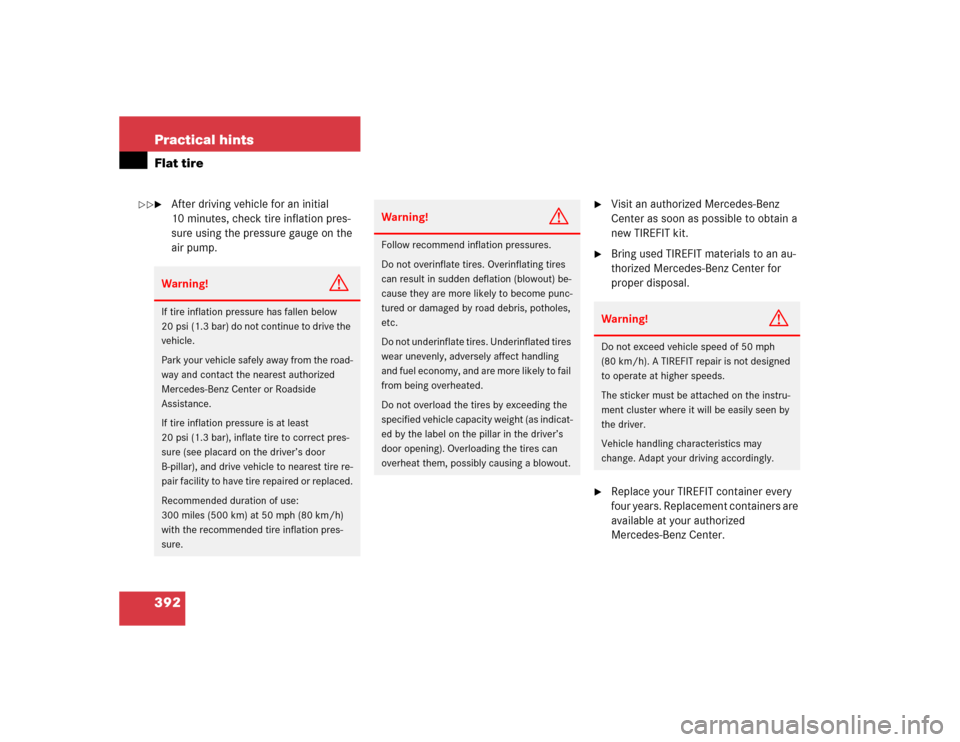
392 Practical hintsFlat tire�
After driving vehicle for an initial
10 minutes, check tire inflation pres-
sure using the pressure gauge on the
air pump.
�
Visit an authorized Mercedes-Benz
Center as soon as possible to obtain a
new TIREFIT kit.
�
Bring used TIREFIT materials to an au-
thorized Mercedes-Benz Center for
proper disposal.
�
Replace your TIREFIT container every
four years. Replacement containers are
available at your authorized
Mercedes-Benz Center.
Warning!
G
If tire inflation pressure has fallen below
20 psi (1.3 bar) do not continue to drive the
vehicle.
Park your vehicle safely away from the road-
way and contact the nearest authorized
Mercedes-Benz Center or Roadside
Assistance.
If tire inflation pressure is at least
20 psi (1.3 bar), inflate tire to correct pres-
sure (see placard on the driver’s door
B-pillar), and drive vehicle to nearest tire re-
pair facility to have tire repaired or replaced.
Recommended duration of use:
300 miles (500 km) at 50 mph (80 km/h)
with the recommended tire inflation pres-
sure.
Warning!
G
Follow recommend inflation pressures.
Do not overinflate tires. Overinflating tires
can result in sudden deflation (blowout) be-
cause they are more likely to become punc-
tured or damaged by road debris, potholes,
etc.
Do not underinflate tires. Underinflated tires
wear unevenly, adversely affect handling
and fuel economy, and are more likely to fail
from being overheated.
Do not overload the tires by exceeding the
specified vehicle capacity weight (as indicat-
ed by the label on the pillar in the driver’s
door opening). Overloading the tires can
overheat them, possibly causing a blowout.
Warning!
G
Do not exceed vehicle speed of 50 mph
(80 km/h). A TIREFIT repair is not designed
to operate at higher speeds.
The sticker must be attached on the instru-
ment cluster where it will be easily seen by
the driver.
Vehicle handling characteristics may
change. Adapt your driving accordingly.
��
Page 400 of 474
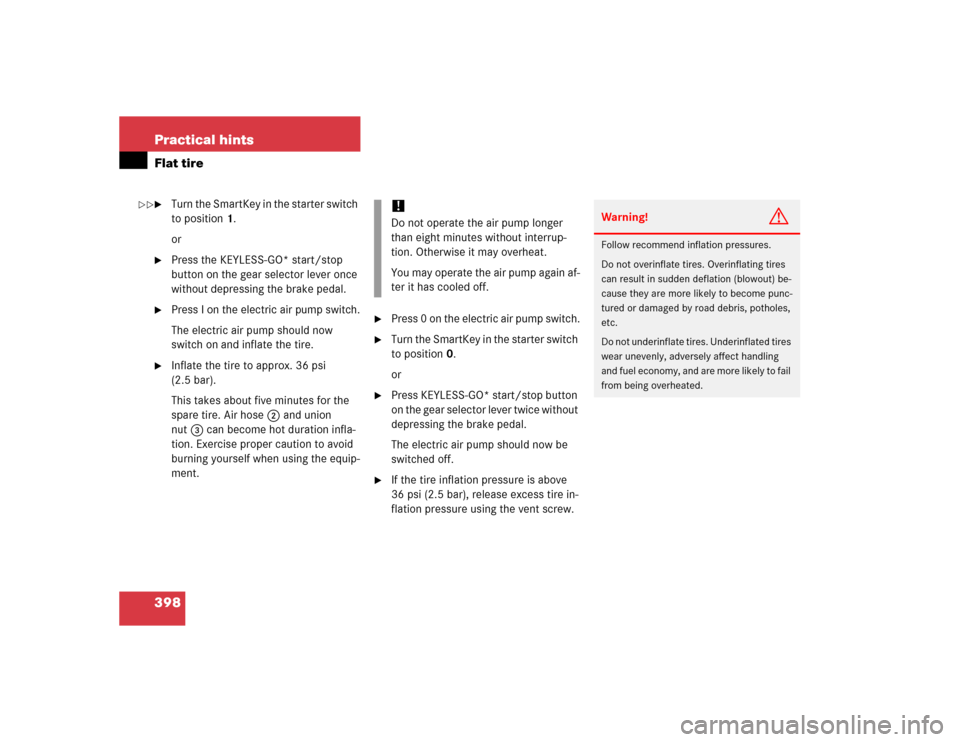
398 Practical hintsFlat tire�
Turn the SmartKey in the starter switch
to position1.
or
�
Press the KEYLESS-GO* start/stop
button on the gear selector lever once
without depressing the brake pedal.
�
Press I on the electric air pump switch.
The electric air pump should now
switch on and inflate the tire.
�
Inflate the tire to approx. 36 psi
(2.5 bar).
This takes about five minutes for the
spare tire. Air hose 2 and union
nut3 can become hot duration infla-
tion. Exercise proper caution to avoid
burning yourself when using the equip-
ment.
�
Press 0 on the electric air pump switch.
�
Turn the SmartKey in the starter switch
to position0.
or
�
Press KEYLESS-GO* start/stop button
on the gear selector lever twice without
depressing the brake pedal.
The electric air pump should now be
switched off.
�
If the tire inflation pressure is above
36 psi (2.5 bar), release excess tire in-
flation pressure using the vent screw.!Do not operate the air pump longer
than eight minutes without interrup-
tion. Otherwise it may overheat.
You may operate the air pump again af-
ter it has cooled off.
Warning!
G
Follow recommend inflation pressures.
Do not overinflate tires. Overinflating tires
can result in sudden deflation (blowout) be-
cause they are more likely to become punc-
tured or damaged by road debris, potholes,
etc.
Do not underinflate tires. Underinflated tires
wear unevenly, adversely affect handling
and fuel economy, and are more likely to fail
from being overheated.
��
Page 417 of 474
415 Technical data
Parts service
Warranty coverage
Identification labels
Layout of poly-V-belt drive
Engine
Rims and tires
Electrical system
Main dimensions
Weights
Fuels, coolants, lubricants, etc.